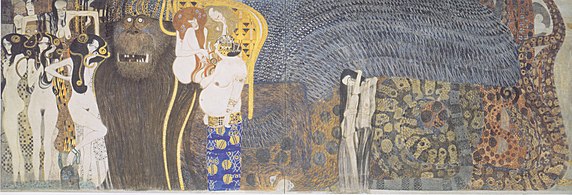art.wikisort.org - Painting
The Beethoven Frieze is a painting by Gustav Klimt on display in the Secession Building, Vienna, Austria.
| Beethoven Frieze | |
|---|---|
 | |
| Artist | Gustav Klimt |
| Year | 1901-1902[1] |
| Medium | Charcoal, graphite, black, red and coloured chalk, pastel, casein colours, gold, silver, gilt stucco, applications (mother-of-pearl buttons, brass uniform buttons, mirror fragments, ground glass, brass curtain rings, upholstering nails, semi-precious stones) on mortar render over reed matting[2] |
| Location | Secession Building, Vienna, Austria |
Description
In 1901, Klimt painted the Beethoven Frieze for the 14th Vienna Secessionist exhibition in celebration of the composer, and featured a monumental polychrome sculpture by Max Klinger. Meant for the exhibition only, the frieze was painted directly on the walls with light materials. After the exhibition the painting was preserved, although it did not go on display again until 1986.[3] The Beethoven Frieze is on permanent display in the Vienna Secession Building in a specially built, climate-controlled basement room.[4]
The frieze is large, standing at 7 feet high with a width of 112 feet. The entire work weighs four tons.[5]
- Left wall: "the yearning for happiness; the sufferings of weak mankind; ..."
- "... their petition to the well-armed strong one, to take up the struggle for happiness, impelled by motives of compassion and ambition.
- Middle wall: the hostile forces; Typhoeus the giant, against whom even gods fought in vain; his daughters, the three Gorgons, who symbolise lust and lechery, intemperance and gnawing care. The longings and wishes of mankind fly over their heads."
- Right wall: "the yearning for happiness is assuaged in poetry. The arts lead us to the ideal realm in which we all can find pure joy, pure happiness, pure love. ..."
- "... Choir of angels from Paradise. 'Joy, lovely spark of heaven's fire, this embrace for all the world."[6]
Depiction on coin

Because of the frieze's fame and popularity, it was made the main motif of a collectors' coin: the Austrian 100 euro Secession Coin, minted on November 10, 2004. The reverse side features a small portion of the frieze. The extract from the painting features three figures: a knight in armor representing "Armored Strength", one woman in the background symbolizing "Ambition" holding up a wreath of victory and a second woman representing "Sympathy" with lowered head and clasped hands.
See also
Notes
- Tobias G. Natter, Benedikt Taschen (2017). Gustav Klimt - The Complete Paintings. Taschen. p. 524. ISBN 978-3-8365-6661-2.
- Tobias G. Natter, Benedikt Taschen (2017). Gustav Klimt - The Complete Paintings. Taschen. p. 524. ISBN 978-3-8365-6661-2.
- "Beethoven Frieze". klimt.com. Archived from the original on May 15, 2012. Retrieved January 22, 2015.
- "The Beethoven Frieze". Secession.at. Vienna Secession. Archived from the original on December 24, 2014. Retrieved January 22, 2015.
- Cohen, Patricia (October 15, 2013). "Heirs Press Austria to Return Looted Klimt Frieze". The New York Times. Retrieved January 22, 2015.
- "History of Art:Gustav Klimt". www.all-art.org. Retrieved 13 January 2020.
External links
- Beethoven Frieze in the online catalog of the Vienna Secession (in German)
- "Portion of Beethoven Frieze".
- Beethoven Frieze, video discussion about the painting from Smarthistory at Khan Academy
На других языках
[de] Beethovenfries
Der Beethovenfries ist ein von Gustav Klimt im Jahr 1901 gemalter Bilderzyklus, der dem Komponisten Ludwig van Beethoven gewidmet ist und die Form eines Frieses hat. An den Wänden eines Saals der Wiener Secession wurde er erstmals anlässlich der 14. Ausstellung der Vereinigung Bildender Künstler der Secession 1902 aufgestellt. Die Bilderfolge ist ein herausragendes Kunstwerk des Wiener Jugendstils.- [en] Beethoven Frieze
[es] Friso de Beethoven
El Friso de Beethoven es un mural alegórico del artista modernista austriaco Gustav Klimt.[fr] Frise Beethoven
La frise Beethoven est une œuvre de Gustav Klimt datant de 1902 et conservée au palais de la Sécession de Vienne.[it] Fregio di Beethoven
Il Fregio di Beethoven è un dipinto di Gustav Klimt, sviluppato su tre pareti per una lunghezza totale di 34 m. Databile al 1902, è conservato nel Palazzo della Secessione a Vienna.[ru] Бетховенский фриз
«Бетховенский фриз» (нем. Beethovenfries) — цикл картин в форме архитектурного фриза работы австрийского художника Густава Климта, подготовленный к XIV выставке Венского сецессиона, проходившей в апреле-июне 1902 года и посвящённой композитору Людвигу ван Бетховену. Фриз считается одним из выдающихся произведений венского югендстиля. Он занимал три стены в левом зале Бетховенской выставки Венского сецессиона, имел в длину около 34 метров и два метра в высоту.Другой контент может иметь иную лицензию. Перед использованием материалов сайта WikiSort.org внимательно изучите правила лицензирования конкретных элементов наполнения сайта.
WikiSort.org - проект по пересортировке и дополнению контента Википедии




![... Choir of angels from Paradise. 'Joy, lovely spark of heaven's fire, this embrace for all the world.[6]](http://upload.wikimedia.org/wikipedia/commons/thumb/5/57/Klimt_-_Beethovenfries_-_Rechte_Seitenwand2.jpg/602px-Klimt_-_Beethovenfries_-_Rechte_Seitenwand2.jpg)